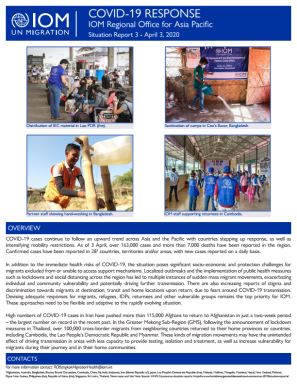-
Countries
-
Data and Analysis
-
Special Focus
-
Crisis Responses
IOM Asia Pacific Covid-9 Response - Situation Report 3 (3 April 2020)
COVID-19 cases continue to follow an upward trend across Asia and the Pacific with countries stepping up response, as well as intensifying mobility restrictions. As of 3 April, over 163,000 cases and more than 7,000 deaths have been reported in the region. Confirmed cases have been reported in 281 countries, territories and/or areas, with new cases reported on a daily basis. In addition to the immediate health risks of COVID-19, the situation poses significant socio-economic and protection challenges for migrants excluded from or unable to access support mechanisms. Localized outbreaks and the implementation of public health measures such as lockdowns and social distancing across the region has led to multiple instances of sudden mass migrant movements, exacerbating individual and community vulnerability and potentially driving further transmission. There are also increasing reports of stigma and discrimination towards migrants at destination, transit and home locations upon return, due to fears around COVID-19 transmission. Devising adequate responses for migrants, refugees, IDPs, returnees and other vulnerable groups remains the top priority for IOM. These approaches need to be flexible and adaptive to the rapidly evolving situation. High numbers of COVID-19 cases in Iran have pushed more than 115,000 Afghans to return to Afghanistan in just a two-week period – the largest number on record in the recent past. In the Greater Mekong Sub-Region (GMS), following the announcement of lockdown measures in Thailand, over 100,000 cross-border migrants from neighboring countries returned to their home provinces or countries, including Cambodia, the Lao People’s Democratic Republic and Myanmar. These kinds of migration movements may have the unintended effect of driving transmission in areas with less capacity to provide testing, isolation and treatment, as well as increase vulnerability for migrants during their journey and in their home communities.

